
In January 2025, we joined National Geographic/GAdventures for a nine day tour of Colombia. After meeting our group on a Saturday night in Bogota (if you'd like, please refer to my blog "Bogota, Colombia: you can pack a lot into two days, but stay longer"), we flew for about 45 minutes on Sunday morning to Armenia in the Quindio region of Colombia, a couple of hundred kilometres west of Bogota. You might ask why we flew that short distance. Here on the flat Canadian prairies, that drive might have taken us two hours, but in Colombia, the estimated driving time can be over six hours (road conditions, construction, terrain, and congestion are all factors). Flying is the only way to go between the cities in Colombia.
I was in for possibly two of the 'best ever' travel days of my life, a combination of coffee consumption, hiking, amazing nature, an historic town, and a few friendly felines.
We reached Armenia mid-morning and were transported to our lodging for two nights, an adorably colourful hacienda on an old coffee plantation, Hacienda La Combia, complete with amazing views, pool, a great walking route through old coffee and plantain fields, and three resident cats, Tito, Tita, and Bakita. The original buiding dates to 1897. I have such good memories of this place.

Sunset.

Colombia is known for the quality of it's coffee. It ranks third in the world for coffee production and is among the first for consumption. In fact, the coffee region in Colombia is a UNESCO World Heritage Site. Sadly, we learned that the 'best' beans are all exported while the lesser quality beans are kept for Colombian consumption - it was still mighty tasty.
After depositing our luggage at our hacienda, we took a short drive to a coffee farm in nearby Montenegro for an afternoon of learning about Colombia's coffee culture. Our resident guide at 'finca La Morelia' taught us all about growing, harvesting, drying, and roasting. At the end, we were challenged to pick the 'best' coffee out of four samples by smelling and tasting. Are you surprised that I was able to pick the best cup? We left with a lot of knowledge, our choice of a coffee drink, and a package of their best beans.

This coffee tour was different from the tour we took to a farm in Guatemala in 2024 as, although the Columbian farm is also a family-run operation, it is on a much larger and more sophisticated scale than the small farm in Guatemala but both great experiences (if you'd like, refer to my blog "Guatemala: Adventure with a social conscience - it's a win-win-win").
One of my fondest memories of all of my fond memories of this trip related, fittingly, to coffee. If you know me, you know that I LOVE coffee, but what to do if the breakfast rooms don't open until 7:00 am or later and I need my coffee and hot water at 6:00 am? I soon learned at the hacienda that Colombians are as addicted as I am, and finding an early morning worker with coffee in his hand was not a problem. The first morning at 6:10 am, I strolled into the beautiful grounds, looked at a groundskeeper, and plaintively said "Coffee?" He motioned to the kitchen where he poured me a cup and when I said "aqua caliente?", he poured me a cup of hot water, as well - and then refilled them. The next morning, he was clearly visible in the yard and said, "Cafe y aqua caliente?" This time, I brought some pesos. I replayed this scenario in Cartagena. I felt a little like I was buying an illicit substance in a back alley.

On our second day in Armenia, our lovely tour guide, "JP", told us that even if we have travelled the world, we were in for something that was possibly more breathtaking than anything we had ever seen. He wasn't wrong.
After a short hour and a half drive, we arrived at the Cocora Valley, part of the Los Nevados National Natural Park. The Cocora Valley is a protected area of groves of gigantic Quindio wax palm trees, the tallest in the world, reaching up to 60 metres (yes, metres) high . The palm tree is Colombia's national tree, and the killing or falling of a tree is illegal. It was 'mindblowing' how palm trees can grow high in the mountains as, here in Canada, we associate mountains with jagged, solid rock surfaces, in no way amenable to the growth of palm trees or plants of any kind. I don't pretend to understand geography or climate, but apparently when ocean winds hit the mountains, a type of humidity and almost daily rainfall occurs. Our local guide lead us on a five kilometre hike through vegetation we had never seen, methodically telling us of the types and traditional medicinal values of many plants and trees. The 'birders' in our group loved the varieties of birds that we don't see in north America. Vultures circled overhead. There are lengthier hikes and horse rides and cycling trails and paragliding available in the valley, but our short visit was an absolute 'moment'.
Then, back to more coffee. After being awed by the Cocora Valley, we stopped in the nearby town of Salento for a visit to a local coffee shop, Brunch de Salento, where we learned about small batch roasting and the 'correct' way to make coffee, be it French press or drip or pour over or modern day 'percolator' (I say 'modern day' because I told the barista about the old aluminum pots with the glass bobble on top that we would place over a burner or campfire - remember?).
We then got to try our hand at being a barista. Suffice it to say, although my coffee tasted great, my coffee art left much to be desired, with no design whatsoever.
After being buzzed by so much coffee sampling, we had a couple of hours to roam the streets of charming Salento. Salento is the oldest town in the area and is considered the gateway town to the Los Nevados National Natural Park with a central old town square, cathedral, and colourful shopping street. It also includes a stairway up Alto de la Cruz hill which is good for hearty exercise and views of the town and Cocora Valley. Here are some street views:
The view of the town from the Alto de la Cruz hill with the church and main shopping street in the background:

Our two days in the Armenia/Quindio regions were magical for me - so far removed from what the world believes Colombia to be, offering us one of the calmest and most serene acommodations, the best coffee, and some of the most beautiful terrain we have ever experienced. As they say, 10/10 highly recommend.
Our next stop was Medellin, and we were in for a totally different learning experience but one that showed us the trauma and resilience of Colombia.








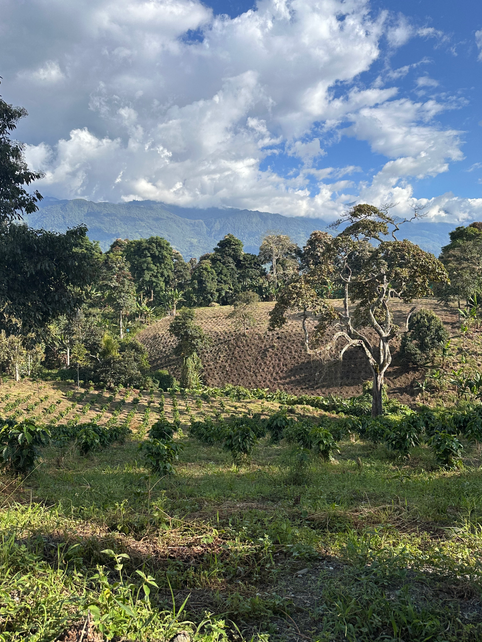





















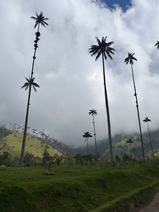















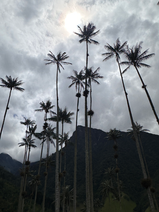



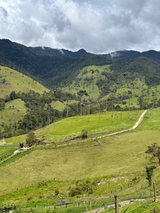















































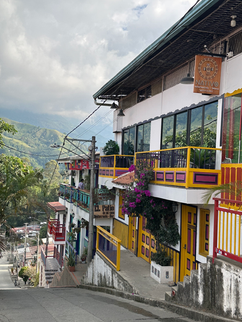
Comments